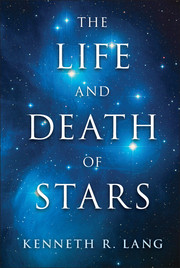Book contents
- Frontmatter
- Contents
- List of Focus Elements
- List of Tables
- Preface
- 1 Light of the Sun
- 2 Gravity and Motion
- 3 Atomic and Subatomic Particles
- 4 Transmutation of the Elements
- 5 What Makes the Sun Shine?
- 6 The Extended Solar Atmosphere
- 7 Comparisons of the Sun with Other Stars
- 8 The Lives of Stars
- 9 The Material Between the Stars
- 10 New Stars Arise from the Darkness
- 11 Stellar End States
- 12 A Larger, Expanding Universe
- 13 Birth, Life, and Death of the Universe
- Quotation References
- Author Index
- Subject Index
- Plate section
7 - Comparisons of the Sun with Other Stars
Published online by Cambridge University Press: 05 February 2013
- Frontmatter
- Contents
- List of Focus Elements
- List of Tables
- Preface
- 1 Light of the Sun
- 2 Gravity and Motion
- 3 Atomic and Subatomic Particles
- 4 Transmutation of the Elements
- 5 What Makes the Sun Shine?
- 6 The Extended Solar Atmosphere
- 7 Comparisons of the Sun with Other Stars
- 8 The Lives of Stars
- 9 The Material Between the Stars
- 10 New Stars Arise from the Darkness
- 11 Stellar End States
- 12 A Larger, Expanding Universe
- 13 Birth, Life, and Death of the Universe
- Quotation References
- Author Index
- Subject Index
- Plate section
Summary
Where and When Can the Stars Be Seen?
Go outside and look up at night to locate a familiar bright star or a pattern of stars such as the Big Dipper. To make this sighting, we must get our bearings here on the Earth, as well as in the sky, and also know the time. After all, the stars only come out at night.
So, once we know where we are, where the stars are located in the sky, and what time it is, we can become astronomers, from the Greek astronomos for “an arranger of stars.” Then, as the great Italian poet Dante Alighieri wrote in the last line of his Inferno, we can “come forth, to look once more upon the stars.”
The Earth has a spherical shape and we can position ourselves on it by using a grid of great circles that specify our longitude and latitude. A great circle divides the sphere in half; the name derives from the fact that no greater circles can be drawn on a sphere.
Our planet spins on an axis that is speared through its center and emerges at the two geographic poles, the North and South Poles. A great circle halfway between these poles is called the Equator because it is equally distant from them. Circles of longitude are great circles that pass around the Earth from pole to pole, perpendicular to the Equator. The starting point for measuring longitudes is the great circle passing through the old Royal Observatory in Greenwich, England, and our longitude is measured westward along the Equator from this reference (Fig. 7.1). Our latitude is the angle measured northward (positive) or southward (negative) along a circle of longitude from the Equator to our place on the Earth.
The Earth’s northern rotation axis now points close to Polaris, also known as the North Star or the Pole Star, which would lie approximately overhead when viewed from the Earth’s geographic North Pole. The latitude of any location in the Earth’s Northern Hemisphere is equal, within about 1 degree, to the angular altitude of Polaris. The uncertainty is due to the fact that Polaris is not exactly at the north celestial pole, where the north end of the Earth’s rotation axis pierces the night sky.
- Type
- Chapter
- Information
- The Life and Death of Stars , pp. 128 - 156Publisher: Cambridge University PressPrint publication year: 2013



